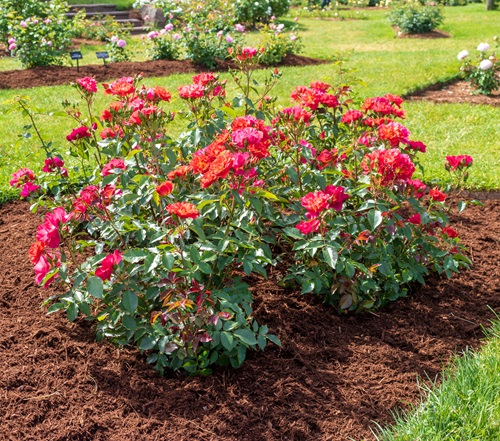While not all need it, here’s a selection of Plants that absolutely Love and benefit the most from Mulching!
Mulching is to apply layers of versatile materials to the soil. This helps stabilize soil temperatures, lock in moisture, protect roots from frost, and offer several garden perks. And while it’s not meant for all flora, here are plants that love and thrive from mulching!
Plants that Love Mulching
1. Tomato

Botanical Name: Solanum lycopersicum
USDA Zone: 2-11
Tomatoes are sensitive plants that have little tolerance for fluctuations and stress. Mulching offers these plants the perfect cushion for extremities. It improves soil nutrition, enables a consistent moisture level while preventing waterlogging, and keeps things steady.
Also, tomato “fruit” begins to rot when it comes into direct contact with the soil, so mulching provides an effective barrier. Use loose mulch like straw, grass clippings, coffee grounds, shredded paper, or sawdust.
2. Strawberry 
Botanical Name: Fragaria × ananassa
USDA Zone: 5-11
Strawberries are usually harvested in summer and planted in fall. In late autumn, mulching them with dry hay or grass insulates and protects them from frost. Mulching also suppresses weed growth.
These plants have short roots and need more watering, especially in the first year. It is also a good practice to pluck off the blooms during the first season to help the plant establish itself.
3. Rose
Botanical Name: Rosa
USDA Zone: 5-11
For roses, mulch acts as a temperature stimulant, warming the soil in cold winters and keeping it cool and hydrated in hot months. Organic mulch also nourishes the soil by slowly breaking down over time.
Try mulching roses in early spring using wood chips, pine, bark, coconut husk, or hay. Apply a new layer every 3-4 months. Remember to add a layer around the base to protect it from the cold as the plant begins to go dormant in winter.
4. Pepper
Botanical Name: Capsicum annuum
USDA Zone: 4-11
While black plastic mulch is a popular choice for peppers, plastic pollution and temperature stress in warm climates cannot be ignored. Biodegradable mulches offer the same benefits without the disposal and leaching issues and help give them that kick of spice!
Grass clippings, depending on the soil’s nitrogen content, or hay are also good options for mulching peppers. It is better to start planting peppers indoors and transplant the seedlings after the last frost date.
5. Hosta
Botanical Name: Hosta
USDA Zone: 3-9
Hostas are famous ornamental shade plants known for their attractive foliage. To ensure yours thrives, mulch it with shredded bark or leaves, compost, and other organic material. Hostas love damp and moist conditions; mulching will help fulfill these needs.
These perennials need a dormant cold period to re-energize where the leaves drop, so mulching before this helps the plant overwinter.
6. Daylilies
Botanical Name: Hemerocallis
USDA Zone: 3-9
Daylilies love a rich, 2-3-inch layer of organic mulch that boosts the soil’s fertility. Use bark, peat moss, or hay mulch, but only apply it at the beginning of the growing period or at the end of the fall season.
7. Squash

Botanical Name: Cucurbita pepo
USDA Zone: 3-11
Squash is an annual that does well with mulching, especially in late fall, to help keep the soil moist and curb competition from nearby invasive species. Using heavy organic mulch like compost improves the quality and quantity of the yield.
Remember not to cover the foliage when using airy mulches, as these plants need plenty of sunlight to thrive.
8. Hydrangea
Botanical Name: Hydrangea macrophylla
USDA Zone: 6-11
Hydrangeas prefer an even layer of mulch on their growing medium to help shield them from temperature drops and improve water retention. Remember never to volcano mulch, i.e., mound mulch up around the base of the plant, as this can lead to rot.
You don’t need to buy mulch—fallen leaves, straw, or dry hay will work just fine! Also, ensure your hydrangea is shielded from direct sun, as it grows best in dappled sunlight or partial shade.
9. Carrot

Botanical Name: Daucus carota subsp. sativus
USDA Zone: 2-11
Carrots prefer mulching to beat the heat and prevent produce-splitting—where roots crack—by conserving water. Carrot roots can split due to excess nitrogen and irregular watering. They also tear from the center if the soil dries out and you try to correct it by overwatering.
If you’re forgetful and don’t want split carrots, use seedless hay or straw mulch to keep the soil evenly moist and cool.
10. Cucumber
Botanical Name: Cucumis sativus
USDA Zone: 2-11
These “vegetables” are 95% water and need hydration aplenty. Mulching prevents water loss and also protects cucumber vines from harsh sunlight. While there are several ways to grow cucumbers, mulching with straw boosts harvest and keeps pests like slugs at bay.
Note: Vertically grown cucumber plants will lose more moisture, so trellises, watering frequency, and mulch should be tweaked accordingly.


